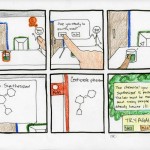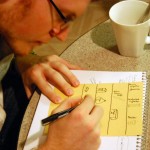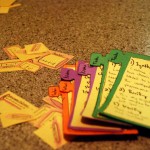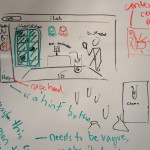Concept
At its basic level, iLab is a shared, virtual Chemistry lab environment on the iPad. It allows multiple users to interact with each other in real time. Instructors create scenarios for the students to role-play without being guided down a specific path. It is up to the students to collaborate with each other or perform some outside research to successfully complete the task.
Learning from one’s mistakes can be the most powerful way for a concept to stick (and is a core tenant of anchored instruction), but mistakes in the Chemistry lab can be extremely dangerous. By creating a virtual environment for Chemistry students to fail safely in, we are allowing them to “play around” with chemicals that they wouldn’t normally be able to play with. This gives them the ability to try, fail, and try again.
Project Responsibilities
- Team facilitation
- Interviewer
- User test facilitation and documentation
- Paper prototype development
- Brainstorming and ideation
- Sketching and iteration
Project Timeline
September 28, 2010 – October 20, 2010
Team Mates
Megan Harris
Mudit Mittal (.pdf)
Nicholas True
Background
The iLab concept was developed in response to a design challenge assignment put forth by Marty Siegel in his Interaction Design Practice course (Fall 2010). The basic notion of the challenge was to develop the next generation of textbooks using the iPad, but the solution had to be “computer imaginative.” It could not just be an electronic version of a textbook, because what would be the point of that? The solution had to take advantage of the medium, in this case the iPad.
Mantra: “More immersive is more better”
My team and I decided on the mantra “More immersive is more better” to help us focus on our problem: textbooks are not immersive or engaging. Our core for this project was to exploit technology in a way that utilized anchored instruction to engage students in an immersive environment that gave them a safe place to fail and learn from their mistakes. Anchored instruction is a concept we came across while researching teaching methods for this assignment. It centers on the notion that learning is easier when a concept is attached to an anchor, like role-play, scenarios, or videos, because the students “identify with the problem and become actively involved in generating solutions” [1].
Target
We focused on a college-level introductory Chemistry course for this project. We designed the project so that it could be extrapolated to include other areas of education as well, but focusing on Chemistry from the outset afforded us the ability to think more critically about our decisions; we were able to think about specifics rather than generalizations.
Methods Used
- Research of teaching methods
- Personas
- Interviews of instructors
- Sketching
- Storyboarding
- Paper prototyping
- Usability testing of prototypes
Attributions
[1] Welcome to the Penn State College of Education. 20 October 2010 http://www.ed.psu.edu/NASA/achrtxt.html.





